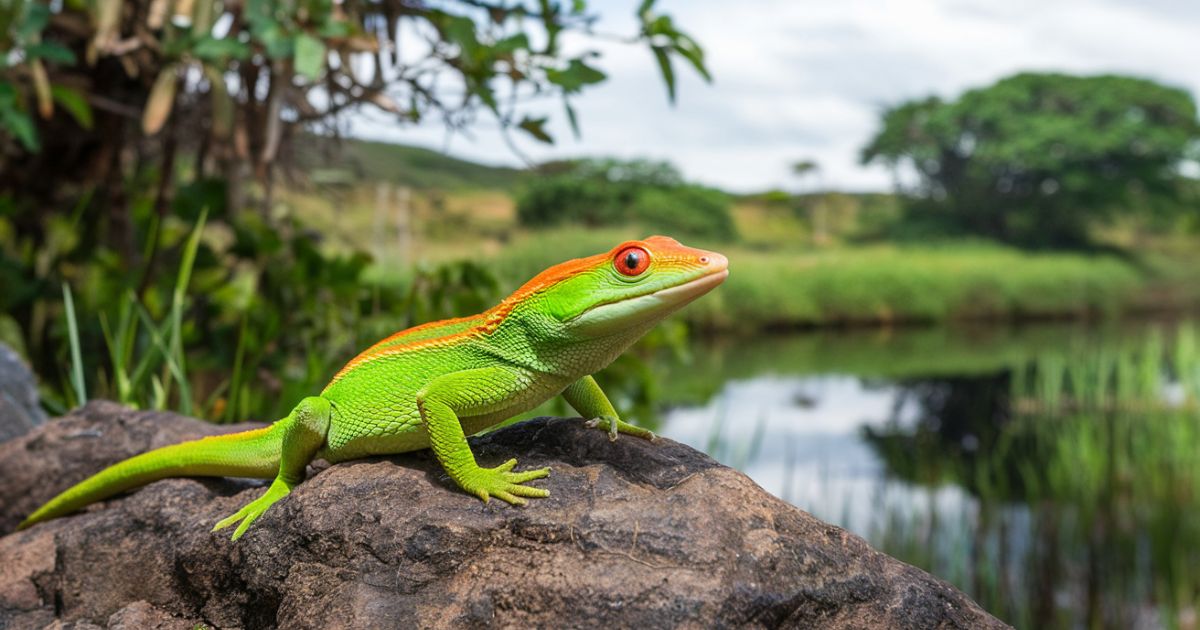The red-eyed crocodile skink, scientifically known as Tribolonotus gracilis, is one of the most fascinating and unique reptile species in the world.
Native to the tropical rainforest habitats of New Guinea, this lizard has captivated the attention of herpetologists and wildlife enthusiasts due to its distinctive appearance and behavior.
With a vibrant red ring encircling its eyes and a body armored with plated spines and bony plates, the skink is often compared to a miniature crocodile.
This blog delves into everything you need to know about this intriguing species, from its diet and habitat to its role in the ecosystem and conservation efforts.
Quick Facts
Here are some quick insights into the red-eyed crocodile skink:
| Feature | Details |
| Scientific Name | Tribolonotus gracilis |
| Class | Reptile |
| Native Habitat | Tropical rainforests of New Guinea |
| Diet | Insectivore |
| Average Size | 8–10 inches (20–25 cm) |
| Weight | 1.3–1.6 ounces |
| Lifespan (Wild) | 6 years |
| Lifespan (Captivity) | Up to 10 years |
| Conservation Status | Least Concern |
| Reproduction | 1 egg per clutch |
The red-eyed crocodile skink plays a vital role in its ecosystem by controlling insect populations and serving as a prey species for predators. Its unique physical traits and behaviors make it a standout in the world of reptiles.
Read More: Pretty And Cute Snail Names With Meanings
About
I LIVE IN ASIA
The red-eyed crocodile skink is endemic to the island of New Guinea, which is shared by Papua New Guinea and Indonesia.
This species thrives in the tropical rainforest habitats of the region, which are characterized by high humidity, dense vegetation, and warm temperatures.
These forests provide the perfect environment for the skink to hide from predators and hunt its insect prey.
Discovered in the early 1990s, the red-eyed crocodile skink was a relatively late addition to documented Papua New Guinea wildlife.
This discovery emphasized the rich biodiversity of the region. However, its shy and secretive nature means that much about its behavior in the wild remains a mystery.
Scientists have noted that the skink prefers to stay near moist soil and leaf litter, which helps it stay hidden and maintain hydration.
I AM AN INSECTIVORE
As an insectivore, the red-eyed crocodile skink has a diet primarily composed of insects, making it an integral part of the rainforest ecosystem.
Its preferred foods include fruit flies and mealworms, as well as small crickets. These insects are abundant in its natural habitat, ensuring a steady food supply.
The lizard’s dietary habits are crucial for maintaining an ecosystem balance. By consuming a variety of insects, the skink helps regulate insect populations, preventing overpopulation and its associated problems.
Additionally, its feeding behavior ensures that plant life in the rainforest is not overrun by herbivorous insects.
RED-EYED CROCODILE SKINKS ARE SOLITARY
The red-eyed crocodile skink is known for its solitary behavior, preferring to live alone rather than in groups. This characteristic is particularly evident outside the breeding season, during which males and females come together briefly.
While pairs of adult skinks have occasionally been observed cohabiting, such instances are rare.
The skink’s reclusive nature is likely an evolutionary adaptation to its environment. Living alone minimizes competition for resources such as food and shelter.
Furthermore, its solitary habits help reduce the likelihood of attracting predators. This behavior, combined with its effective protective armor, makes it a master of survival in its habitat.
SUIT OF ARMOR
The red-eyed crocodile skink is aptly named for its crocodile-like appearance, highlighted by its plated spines and bony plates. These physical features serve as a natural protective armor, shielding the skink from potential predators.
The four distinct rows of spines running along its back are not only functional but also contribute to its unique aesthetic.
When threatened, the skink employs additional defense mechanisms, including playing dead or vocalizing. These strategies, combined with its armor-like plates, enhance its ability to evade predators in the wild.
This impressive adaptation underscores the ingenuity of nature in designing creatures perfectly suited to their environments.
HELPING THE RED-EYED CROCODILE SKINK IN THE WILD
Conservation efforts are vital for ensuring the survival of species like the red-eyed crocodile skink, even though its conservation status is currently listed as “Least Concern.”
Initiatives such as those led by the Fort Wayne Zoo conservation program play a significant role in raising awareness and funds for wildlife conservation.
Every year, organizations like the Fort Wayne Zoo donate resources to protect wildlife and wild places, ensuring that species like the red-eyed crocodile skink continue to thrive in their natural habitats.
Public awareness campaigns and habitat preservation projects are essential for mitigating threats such as deforestation and climate change.
I AM IMPORTANT TO MY ECOSYSTEM
The red-eyed crocodile skink is not just a fascinating creature but also a keystone species in its habitat. Its role as an insectivore means that it helps maintain the delicate balance of the rainforest ecosystem.
By keeping insect populations in check, the skink indirectly supports plant life and reduces the risk of agricultural pests spreading into human settlements.
In addition to its ecological contributions, the skink serves as an indicator species. Its presence reflects the health of the environment, making it a valuable subject for scientists studying the impacts of environmental change.
As such, protecting the red-eyed crocodile skink also means safeguarding the biodiversity of tropical rainforest habitats in New Guinea.
Wrap It Up
The red-eyed crocodile skink, or Tribolonotus gracilis, is a truly remarkable species that exemplifies the beauty and complexity of nature.
From its striking appearance to its crucial role in maintaining ecological balance, this lizard is a testament to the importance of wildlife conservation.
While its current conservation status is stable, ongoing efforts are necessary to protect its natural habitat and ensure its survival for generations to come.
As we continue to learn more about the red-eyed crocodile skink and its place in the rainforest ecosystem, it becomes increasingly clear that even small and seemingly insignificant creatures can have a profound impact on the world around them.
By supporting wildlife conservation efforts and spreading awareness about this unique species, we can contribute to a healthier and more sustainable planet.

Streamnexs.com offers a creative collection of Animal and Bird Name Ideas, helping pet owners, enthusiasts, and Bird Lovers Find Unique, Meaningful, and Fitting Names for their Feathered and Furry Friends.
